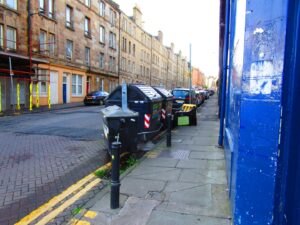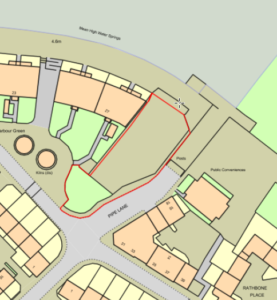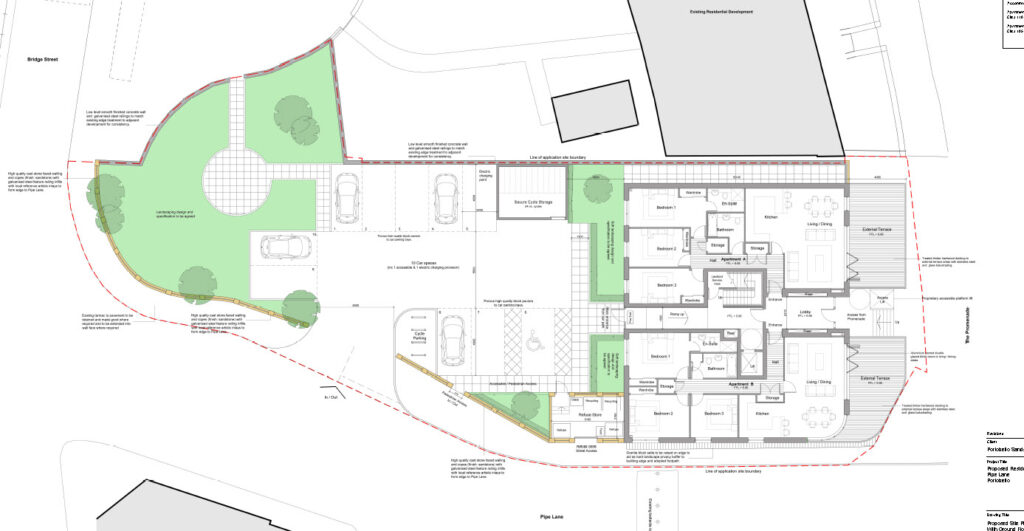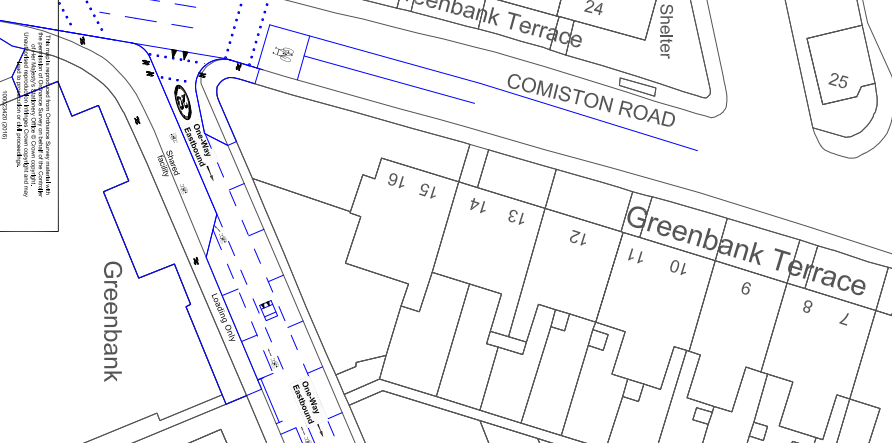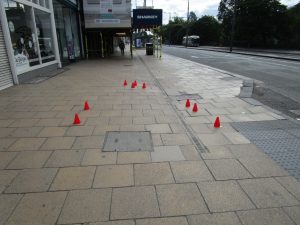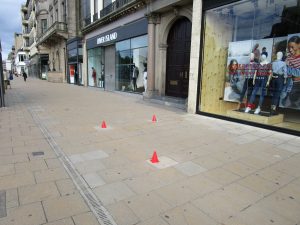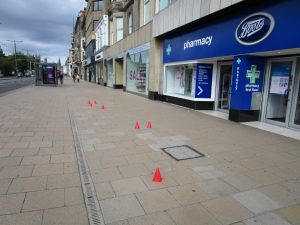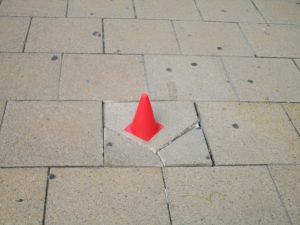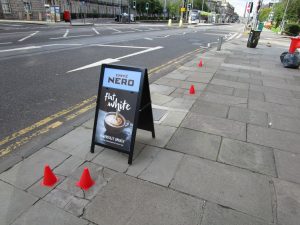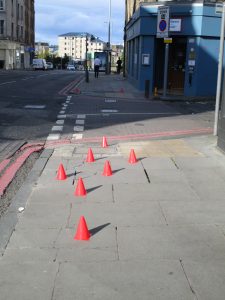CEC COMMUNAL WASTE BINS REVIEW Project: Comments from the Living Streets Edinburgh Group (LSEG)
LSEG welcomes the current review of the location of Communal Waste Bins in the city, and the intention to create bin hubs and rationalise the scattered locations of the various types of bin. Under existing conditions there are far too many such bins that are poorly located or left mislocated on pavements, so creating unnecessary obstacles for pedestrians. In numerous instances they also collect other clutter items around them. This review is timely in the context of the covid virus with heightened concern over clutter and the need for more space on pavements to allow social distancing. The reduction of bin clutter is also central to the realisation of the council administration’s objective (27), to tackle clutter and pavement parking.
We have a number of questions and concerns however, about the specifics of the review and how successfully they will be translated into practice.
One particular concern is the intention to go with wheeled communal bins everywhere, rather than the ones with fixed positions that can then be lifted automatically with the lorry correctly alongside. The latter are all in the carriageway of necessity and, unlike wheeled bins, cannot be left out of position on pavements! Given the frequency with which wheeled bins are currently so left as obstacles to pedestrian movement, both on pavements and in the carriageway where blocking crossing points, we would wish to see fixed positions retained wherever this is practicable.
As of now wheeled bins are to be found out of position all over the city. Even when in the carriageway they are often to be seen too close to junctions or where they obstruct dropped kerb crossing points for pedestrians or block cycle lanes. They are left there after emptying by contractors, or they are subsequently moved or sometimes blown there. Can we please therefore be informed as to what additional measures will be taken to ensure that bins are repositioned within the defined hub positions? Under the current regime, even where there are defined areas for bin location, all too often these are ignored or treated as only approximate indicators. We are not convinced that the new bin hub settings will be sufficient to ensure that contractors do correctly reposition the bins. So without exception the hubs should be in roadway rather than on pavements. If gradients are a problem for this then regrading of the carriageway is the answer, not putting bins on pavements. Where there is a sufficient excess of pavement space to allow bin hubs to be located there without inconveniencing pedestrians, then it would be acceptable for that space to be used, but it must then be regraded to carriageway level in the process; otherwise there will still be out of position bins rolling around on pavements.
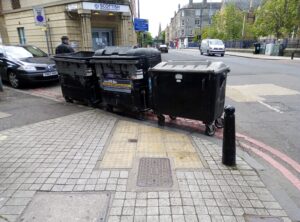
The current review is seen to only be covering communal bins. It does not embrace the residential or trade waste bins that are equally of concern for pedestrians, given that these bins are also frequently left on pavements for periods of time out of all proportion to the needs for collection, and in excess of the times authorised by the CEC. We call for a complementary review to be undertaken of ways to reduce the problems and clutter associated with these bins also.
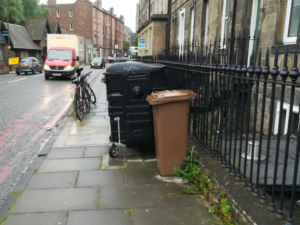
There are problems arising from both residents and retailers leaving bins out permanently or semi-permanently in some cases, and for excessively long periods in many others. The situation with trade waste bins does seem to have been improved somewhat over recent years, but the levels of regulatory and enforcement activities are still far from adequate. Woeful conditions for pedestrians are being created on pavements as a result, whereby wheelchair users and other vulnerable pedestrians are at times simply unable to use them. Council policy should make it clear that residential bins must be left on the roadway side of the kerb where the pavement width is less than 1.5m. The council should also seek powers to levy fines on residents who leave bins out permanently.
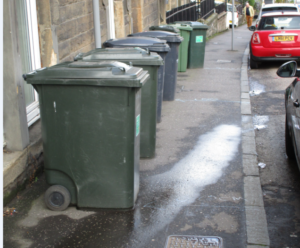
In many instances residents’ bins are also left blocking pavements after emptying by the contractors, and it is clear that insufficient efforts are being made to encourage compliance with or to enforce the rules. At the very least there surely should be clear instructions that emptied bins must not be left anywhere on pavements narrower than 2m, with penalties introduced for contractors who fail to ensure that their staff follow this in practice. Equally if bins are replaced on pavements where they are wider than 2m, there should be penalties imposed for placing them in obstructive positions.
There is also a need for the current review to be followed up with a much wider review aimed at minimising the extent to which bins of all kinds are located on streets in Edinburgh, where space is so often limited and in demand for multiple other uses, and in scarce supply for pedestrians in particular. There is potential for bins to be relocated off street in many places, and for space demands to be reduced by underground storage; as can be seen in a number of the cities with which Edinburgh both competes (e.g. for tourism) and likes to compare itself with. It is accepted that underground storage can be too expensive and will not be an option everywhere, but opportunities to introduce it arise continually in association with development and redevelopment processes, and CEC should initiate a system to take these opportunities.
This wider review should also embrace the waste management objectives set out in the finalised Edinburgh City Centre Transformation report of 12 September 2019, which approved early action to address waste collection through “operating plans for residential, commercial and public waste collection, including operators, vehicle restrictions, time restrictions and consolidation” (para 5.3.5). Potentially these plans will help deliver the aspirations in the ECCT to make a more walkable city, less dominated by traffic, especially heavy vehicles. 26 ton bin lorries have no place in many of Edinburgh’s streets and alternative ways of collecting waste must be explored, as already agreed by the Council.
